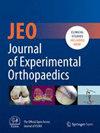Effect of corticosteroids and hyaluronic acid injections on knee osteoarthritis trajectory
Abstract
Purpose
Knee osteoarthritis (OA) is one of the most prevalent orthopaedic pathologies. Intra-articular injections represent a common option to manage this condition. The aim of this study was to quantify and compare the effectiveness of corticosteroids (CS) and hyaluronic acid (HA) in affecting the knee OA trajectory over time.
Methods
Patients were selected from the Osteoarthritis Initiative database, a prospective, multicentre, longitudinal, observational study, including 254 knees who received CS or HA injections. For each patient, demographic characteristics, Kellgren–Lawrence (KL) grade, joint space narrowing (JSN) of the medial and lateral compartments, knee swelling, visual analogue scale (VAS) for pain, Western Ontario and McMaster Universities Osteoarthritis Index (WOMAC), and subsequent prosthesis implantation were analysed. Patients were followed from baseline to 36 months of follow-up. Clinical improvements were evaluated according to the minimal clinically important difference (MCID): VAS = 1.4, WOMAC = 6.4.
Results
Both CS and HA groups showed no overall clinical worsening from the baseline to the 36-month evaluation. On the other hand, they both presented a worsening at short- and long-term of KL OA grade (CS: p < 0.001 and p = 0.018; HA: p = 0.042 and p = 0.012) and medial JSN (CS: p < 0.001 and p = 0.009, HA: p = 0.033 and p = 0.003), while lateral JSN deteriorated only in the CS group at short-term (p = 0.030). The analysis of patients obtaining an improvement exceeding the MCID showed that CS outperformed HA at short-term for WOMAC (44.9% vs. 29.0%, p = 0.022) with a tendency also for VAS (44.3% vs. 31.9%, p = 0.086). However, only HA provided a clinically relevant long-term improvement of WOMAC (p = 0.014, MD = 6.7) and VAS (p = 0.024, MD = 1.2). The analysis of patients requiring total knee arthroplasty (TKA) before the end of the study did not show differences between CS and HA.
Conclusions
The symptomatic trajectory after 36 months showed no worsening in knee OA patients undergoing intra-articular injections and different benefits based on the treatments: CS offered clinically relevant benefits compared to HA at short-term while HA provided superior functional improvement at long-term, with no differences between the two treatments of radiographic OA evolution, knee swelling, and progression to TKA.
Level of Evidence
Level II.




 求助内容:
求助内容: 应助结果提醒方式:
应助结果提醒方式:


